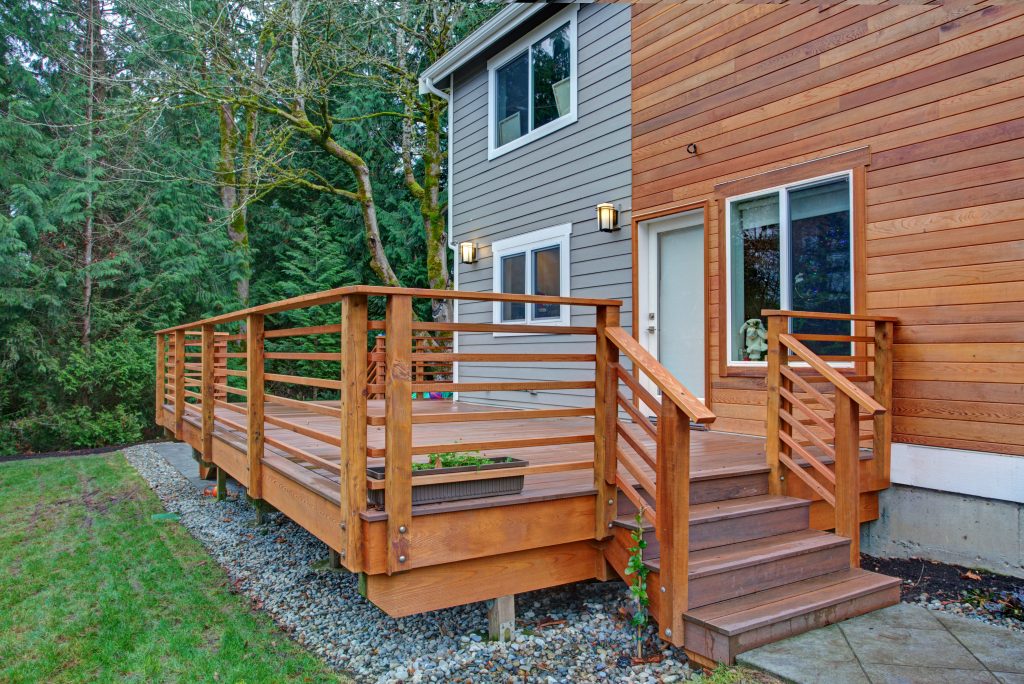
Decking is a common practice in our culture, be it home improvement or starting the construction from the ground.
Still, most people don’t realize the high skill level required to master the art of decking. It requires a master deck builder, whether you choose a composite or natural deck material such as wood, you should be aware that those boards move! Most people ignore this, increasing the risk of you buying excellent material and trashing it after one season because of the wrong installation practice.
The Decking market offers a lot of options, starting from the traditional to the most innovative methods. Working as a Minnesota Contractor, we’ve encountered a ton of questions regarding the best choice for decking materials. This gave us the idea to create an informative blog for the top decking materials that can be used for home improvement.
The most popular decking option is wood, It is easy to install, naturally strong and feels good as well. For maintenance it requires cleaning and if not taken care of, it can rot, splinter and even wrap. To maintain wood’s natural color, it should be cleaned every 2-3 years to keep it looking its best. Now, there are various options available for wood decking:
• Pressure-treated wood
This is the least expensive and the most common decking material in home improvement\construction that can last for 15 years. Most of the pressure-treated woods are made from the southern yellow pine that can splinter quickly, if not maintained properly. While working with pressure-treated wood, always wear a mask, use gloves. Never burn it because of the presence of toxic chemicals in the wood that prevents the rots and termites, the emitted gases upon burning can be harmful to your health. The chemicals used are highly corrosive, use only stainless-steel fasteners for the best results.
• Tropical Hardwoods
These are extremely dense and highly durable; they are also rich in color. Being resistant to insects and decay, these can last for 25 years. On the other side, these are expensive, heavy, and hard to work.
Tip: In case there is a lot of exposure to the sun, avoid using dark wood for your deck because they heat up like an oven at times.
• Redwood and Cedar
Redwood and cedar have their defenses against rot and insects, they also last for 20 years. These woods are stiff and lightweight, but they are also soft and get damaged easily by foot traffic. The light-colored Port Orford Cedar is the hardest and the most wear-resistant cedar. Like every other wood, prolonged sun exposure can fade its natural color, hence regular application of sun-blocking finishes is necessary.
The Composite Deck is a blend of waste wood fibers and plastic. Composite is heavier and more expensive than most wood deck materials. Unlike wood, composites need to scrubbed regularly to prevent mildew. They are not as stiff as wood; they move along with the change in temperature. During the construction\home improvement phase, make sure that the manufacturer’s installation instructions are followed properly. Use special fasteners to prevent bumps to happen while screwing through the face.
Like wood there are many composite deck options available:
● The same texture on both sides
Here, the installation process is less complicated, when the board is having the same texture on both sides. This makes it very easy for laying the pranks, as there is no possibility of putting it the wrong way.
● The different texture on each side
This deck Installation can take a little more time when the board is having a different texture on each side. It gives you more options to choose from. Such as making a deck with a combination of the smooth and wood-grain face.
● Engineered
An engineered composite deck is a by-product of wood that is made by binding and fixing strands, particles, etc. using adhesives or any other fixing method. Generally, these boards have grooves on the underside that make the board lighter with making any compromise on strength & stiffness. These grooves allow us to make use of hidden fasteners, so there are no screws visible on the deck.
Plastic decking materials are splinter-free and need almost zero maintenance, except the occasional cleaning. But, it feels, looks and sounds completely different from wood-based deck materials. Because of its complex fastening systems, the pieces can move along with the change in temperature. They also squeak when you walk on them.
● PVC
The PVC decking contains 100% polyvinyl chloride and no wood at all. The PVC decking is an expensive option in the decking industry. Compared to other products, it has lower maintenance requirements and provides significant fade and stain resistance as well.
● Polystyrene
Polystyrene is easy to install, lightweight and has great thermal properties. The expanded polystyrene (EPS) blocks are widely used for construction\home improvement. These blocks are resistant to vibration, aging, and rot. The EPS blocks are a cost-effective measure for permanent shuttering and recycling that doesn’t harm our environment. Due to its great acoustic and thermal properties, it reduces energy consumption which makes it cost-efficient.